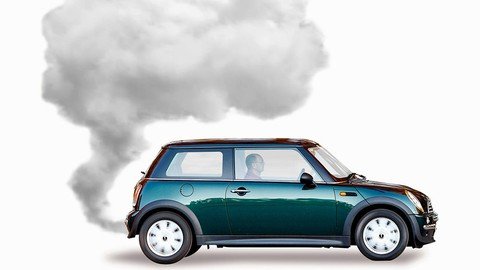
Last updated 5/2022
MP4 | Video: h264, 1280x720 | Audio: AAC, 44.1 KHz
Language: English | Size: 989.54 MB | Duration: 2h 3m
Understand How Engine Emissions Causes Air pollution , Type of Engine Emissions and How to Control these Emisions
What you'll learn
Understand the causes and effects of air pollution due to internal combustion engines
Learn about the European Emission Standards for IC Engine Emissions
Classify engine emissions into exhaust and non-exhaust emissions
Discover the causes of hydrocarbon emissions and factors such as incomplete combustion, crevice volumes, and deposits on walls
Study the different types of engine emissions including hydrocarbons, carbon monoxide, oxides of nitrogen, particulates, aldehydes, and lead
Learn about photochemical smog and oxides of sulfur emissions
Explore various methods for controlling IC engine emissions including modification in engine design, combustion chamber, ignition timing, and exhaust gas.
Study the use of thermal converters, catalytic converters, exhaust manifold reactor, exhaust gas recirculation, particulate traps, and crankcase blowby
Understand how modification of fuels can help in controlling emissions
Learn how to implement the above techniques to reduce carbon footprint
Requirements
It would also be beneficial for students to have some background in science, physics, or engineering to fully grasp the technical and scientific concepts discussed in the course.
It is also recommended that you have a desire to learn about the environment and willing to take steps to reduce the personal carbon footprint.
Description
Welcome to the "Mastering the Science of Internal Combustion Engine Emission" course.Are you interested in understanding how engine emissions contribute to air pollution and how to control them? If so, this course is for you!In this course, you will learn about the various types of pollutants emitted by internal combustion engines, including carbon monoxide, nitrogen oxides, and hydrocarbons. You will also learn about the differences between gasoline and diesel engines, and how their emissions affect the environment.You will learn about the negative impacts of engine emissions on public health, including respiratory diseases like asthma and eye irritation. You will also learn about the contribution of engine emissions to acid rain and climate change.But it's not all bad news! This course will also provide you with strategies for reducing engine emissions and improving air quality. You will learn about different technologies and methods for controlling emissions, such as catalytic converters and exhaust gas recirculation systems. You will also learn about the importance of proper fuel consumption and maintenance to reduce emissions.Throughout the course, you will have the opportunity to apply your knowledge through interactive quizzes and hands-on exercises. You will also have access to a variety of learning resources, including video lectures, readings, and online simulations.Join us on this important journey as we explore the world of engine emissions and learn how to control them for a healthier, cleaner environment!COURSE OUTLINEAir Pollution due to IC EngineEuro Norms / European Emission Standards of IC Engine Emissions Classification of Engine Emissions (Exhaust and Non-Exhaust Emissions)Causes of Hydrocarbon EmissionIncomplete CombustionCrevice Volumes and Flow in CrevicesLeakage past the Exhaust ValvesValve OverlapDeposits on WallsOil on Combustion Chamber WallsType of Engine EmissionsHydrocarbon Emissions from SI and CI EngineCarbon Monoxide (CO) EmissionsOxides of Nitrogen (NOx) EmissionsPhotochemical SmogParticulates EmissionAldehydes and Lead EmissionOxides of Sulfur (SOx) EmissionsHow to Control IC Engine Emissions in the following ways.Modification in Engine Design & Operating ParametersCombustion Chamber Configuration Lower Compression RatioModified Induction SystemIgnition TimingReduced Valve OverlapEmissions Control by Exhaust Gas OxidationThermal ConvertersCatalytic ConvertersExhaust Manifold ReactorExhaust Gas RecirculationParticulate TrapsCrankcase BlowbyEmission Control by Modification of Fuels
Overview
Section 1: Introduction
Lecture 1 Introduction
Lecture 2 Air Pollution due to Internal Combustion Engine
Lecture 3 Euro Norms / European Emission Standards for Petrol & Diesel Vehicles
Lecture 4 Classification of Engine Emissions (Exhaust and Non-Exhaust Emissions)
Lecture 5 Hydocarbon Emissions
Lecture 6 Hydrocarbon Emission from SI and CI Engines
Lecture 7 Corbon Monoxide (CO) Emission
Lecture 8 Oxides of Nitrogen (NOx) Emissions
Lecture 9 Photochemical Smog and Particulates
Lecture 10 Aldehydes and Lead (Pb) Emissions
Lecture 11 Oxides of Sulpher (SOx) Emission
Lecture 12 Control Enginer Emissions
Engineering students and professionals studying or working in the field of automotive engineering, mechanical engineering, or environmental engineering,Scientists and researchers working in the field of air pollution or emissions control,Environmentalists and concerned citizens who want to learn more about the impact of internal combustion engines on the environment and how to reduce their own carbon footprint,Government officials and policy makers who are involved in creating regulations and standards for emissions control,Automotive technicians and mechanics who want to learn more about emissions control systems and how to maintain them,Anyone who is interested in understanding the science behind air pollution and the ways in which it can be controlled
Screenshots
https://rapidgator.net/file/7c32096445ac0676717260fcc6566c48/Mastering_the_Science_of_Internal_Combustion_Engine_Emission.rar.html https://uploadgig.com/file/download/1bb58A4aE9bacCef/Mastering_the_Science_of_Internal_Combustion_Engine_Emission.rar






